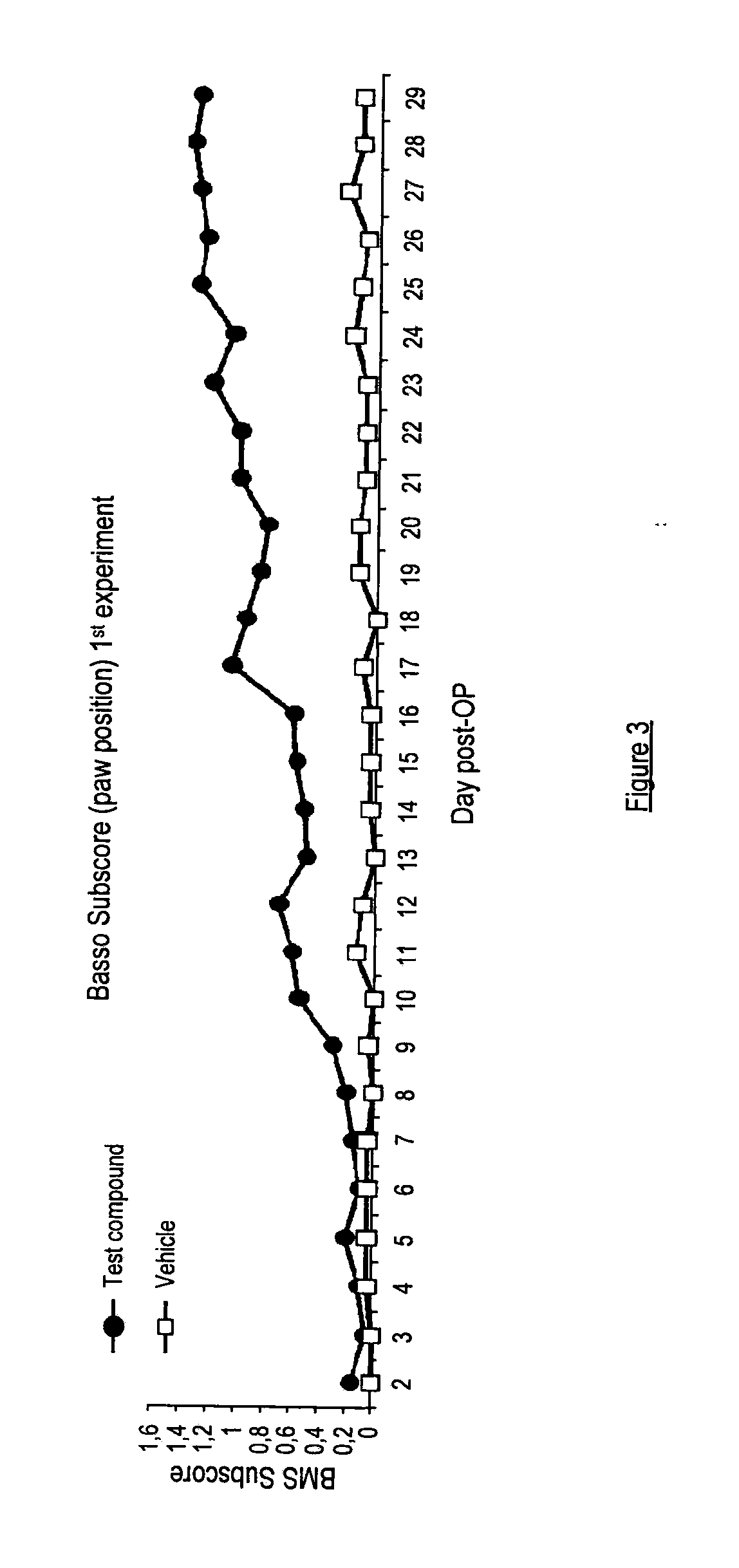Use of angiotensin ii agonists
an angiotensin ii and agonist technology, applied in the field of compounds, can solve the problems of not being able to reduce the paralyzing effect of injury, not being able to show in vitro, and not being able to promote regrowth of functional nerve fibres, etc., to achieve the effect of promoting reinnervation and/or remyelination, and increasing the expression of various neurotrophic factors
- Summary
- Abstract
- Description
- Claims
- Application Information
AI Technical Summary
Benefits of technology
Problems solved by technology
Method used
Image
Examples
example 1
[0156]The following compounds of the invention were prepared by methods described herein or by the methods of international patent application no. WO 2002 / 096883, which document is hereby incorporated by reference.
[0157](i) N-Butyloxycarbonyl-3-(4-imidazol-1-ylmethylphenyl)-5-iso-butylthiophene-2-sulfonamide (this compound is particularly preferred);
[0158](ii) N-iso-Butyloxycarbonyl-3-(4-imidazol-1-ylmethylphenyl)-5-iso-butyl-thiophene-2-sulfonamide;
[0159](iii) N-iso-Propyloxycarbonyl-3-(4-imidazol-1-ylmethylphenyl)-5-iso-butyl-thiophene-2-sulfonamide;
[0160](iv) N-(Butoxyacetyl)-3-(4-imidazol-1-ylmethylphenyl)-5-iso-butylthiophene-2-sulfonamide;
[0161](v) N-Butyloxycarbonyl-3-(4-imidazol-1-ylmethylphenyl)-5-butylthiophene-2-sulfonamide;
[0162](vi) N-(Butylamino)carbonyl-3-(4-imidazol-1-ylmethylphenyl)-5-iso-butyl-thiophene-2-sulfonamide;
[0163](vii) N-Butylsulfonyl-3-(4-imidazol-1-ylmethylphenyl)-5-iso-butylthiophene-2-sulfonamide;
[0164](viii) N-Butylsulfonyl-3-(4-imidazol-1-ylmethylph...
example 2
[0171]Spinal Cord Contusion Injury
[0172]Spinal cord injury and cortical spinal tract (CST) tracing were performed as described in (Boato et al. 2010). Briefly, Balb / C mice (20-24 g; 9- to 11-weeks-old) had a dorsal lam inectomy at thoracic level (T8), followed by a contusion lesion with a modified SPI Correx Tension / Compression Gage (Penn Tool, Maplewood, N.J.) for controlled compression of the mouse spinal cord for 1 second at 20 cN. A gelfoam patch containing 1 μM the compound of Example 1(i) was then placed on top of the perforated dura (only in the second experiment, see Example 3), the muscles were sutured and the back skin closed with wound clips. Recovery of function after SCI was determined by scoring the locomotor hindlimb performance in the open field with the BMS, a 0-9 rating system based on the BBB scale and specifically designed for the mouse (Basso D. M., et al., Journal of Neurotrauma, Volume 23, No. 5, 635-659 (2006)). Under blind conditions, investigator evaluated ...
example 3
[0174]As part of the study detailed in Example 2, two groups of mice were treated with the compound of Example 1(i) via different routes: systemically (via i.p.) or in a gel placed at the site of injury. The neurological outcome (scored using the BMS) in the treated mice showed no statistically significant difference between the mice treated via these different routes (see FIG. 2).
PUM
 Login to View More
Login to View More Abstract
Description
Claims
Application Information
 Login to View More
Login to View More - R&D
- Intellectual Property
- Life Sciences
- Materials
- Tech Scout
- Unparalleled Data Quality
- Higher Quality Content
- 60% Fewer Hallucinations
Browse by: Latest US Patents, China's latest patents, Technical Efficacy Thesaurus, Application Domain, Technology Topic, Popular Technical Reports.
© 2025 PatSnap. All rights reserved.Legal|Privacy policy|Modern Slavery Act Transparency Statement|Sitemap|About US| Contact US: help@patsnap.com



